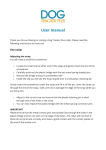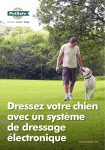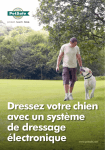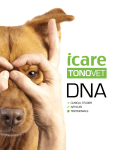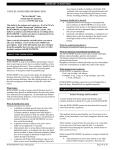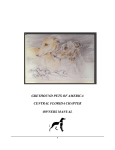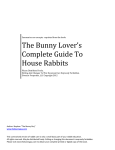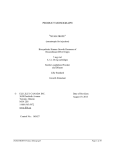Download User manual - Dog Tracker Plus
Transcript
User manual Thank you for purchasing or renting a Dog Tracker Plus collar. Please read the following instructions for best use. The collar Adjusting the strap You will need a small flat screwdriver 1. Locate the small hole at either end of the clasp and gently insert the end of the screwdriver 2. Carefully prise out the plastic bridge with the two metal spring-loaded pins 3. Remove the bridge and put it somewhere safe 4. Inside the clip you will see the strap looped over a small plastic retaining pin. Gently insert the screwdriver under the strap and lift it off the pin. Lever the strap out through the end of the clasp. Take care not to damage the edge of the strap while you are doing this 5. Adjust to the correct size and ensure that the plastic retaining pin is sited through one of the holes in the strap 6. You can now replace the plastic bridge with the metal sprung connector pins IMPORTANT Please ensure that the metal contact pins are pushed fully through the holes in the plastic bridge and do not catch on the edge of the holes. The collar will not work if these do not protrude correctly and make a good contact with the contact plates on the end of the buckle unit. Attaching a lead IMPORTANT If you wish to attach a lead directly to the collar you should purchase a Dog Tracker Plus lead strap that includes a D ring for this purpose. For details go to shop in the information section of the app, go to http://store.dogtrackerplus.co.uk or call Customer Services on 01442 877796. You should not attach a dog lead directly to the tracking collar. We do not accept any responsibility for any loss or damage caused by the failure of the collar while attached to a dog lead or leash. Remember to transfer your dog’s collar tag to the lead strap. Locking the collar Once the collar is latched simply put the key into the lock on the side of the buckle and turn it anti-clockwise and the collar will lock. If you wish to undo the lock then insert the key into the lock and turn it clockwise. Take care not to force the lock in either direction. If it does not turn easily make sure that it is properly inserted into the lock and try again. Latching and unlatching The clip on the buckle is designed to be quite stiff. To ensure easy unlatching, press the top release button and press down on the clasp and buckle unit (as if slowly breaking a pencil). It should then undo easily. Try this before putting the collar on your dog. Switching the collar on and off The collar does not have an on/off button. It will automatically switch on when the clasp and buckle are latched, and switch off when unlatched. While not in use you should keep the collar unlatched to preserve battery life. Charging the collar To charge the collar, insert the charger clip into the buckle end of the strap. The clip end with the small hood has to be at the opposite end to the lock. It will only fit in one way. Then fit the jack-lead from the charger plug into the socket on the charger clip. The left hand battery test light will show amber when charging. From flat to a full charge will take 2 - 3 hours. The left hand LED will show green when fully charged. Buttons and LEDs When the collar is latched the right hand LED will flash red to indicate that the collar is in track mode. The middle LED will occasionally flash amber to show that the GPS is calculating its position. When the collar is latched you can hold down the yellow test button for 3 seconds to see if the collar is fully operational. The 3 LEDs will light simultaneously and may be either Green (fully operational), Amber (operational but without signal), or Red (switched off). Panic button When the collar is latched you can hold down the red panic button for 3 seconds to send an alert including your location to all phones linked to the collar. The alert is a quick way to let others know you have a problem, without using your mobile phone. Wearing the collar The collar is curved to fit around a dog's neck. Small and medium dogs typically wear the collar with the straps on the top and bottom of their neck. Larger dogs may also wear it with the buckle at the back of their neck. It is preferable that the buckle does not point straight at the ground as the GPS antenna is situated in the buckle and requires a view of the sky. Once fitted there should be enough room to get one or two fingers under the collar. Safety advice The collar contains a rechargeable Li-ion battery which is sealed inside the larger plastic housing. The battery should not be accessed or removed. There are no user-serviceable parts in the collar, and no attempt should be made to open the casing or buckle unit. Should you have any problems with the unit, or need to dispose of the unit, please return it to us. The collar is waterproof, but we do not encourage its immersion in water for any length of time. It is important that you keep a key for the collar with you at all times – this will ensure you can remove the collar should your dog become caught for any reason. Servicing We can service the collar and replace worn parts – please contact Customer Services for details. Disposal Please do not dispose of your collar at home. You can return it to us so that we can dispose of it safely in compliance with EU regulation. Phone settings Data In order to use the where’s my dog? and geofence features you must enable data services on your phone and allow the app to use your current location. Once you have enabled data services, Dog Tracker Plus operates in live track mode at all times to provide the best possible location services. You can opt to switch off live tracking to conserve battery power in circumstances where it will be difficult to charge your collar for more than two days. For instructions on how to do this go to movement sensor in the user manual. GPS For the most accurate location search we recommend you enable GPS in your phone’s settings. Please note GPS is not designed for use indoors. The technology works best outdoors where accuracy of a few metres can be achieved. Using the collar abroad Dog Tracker Plus does not charge you for using the collar or app abroad but you could incur additional charges from your phone operator when Dog Tracker Plus uses data services to send you location data. This should be very low under normal use. In addition you could be charged for data services by Facebook or Twitter if you send or receive large data packages such as video, photography or maps. We recommend you switch data roaming on permanently as this will ensure effective location services with the collar but you should be careful how you use other data services while outside the UK. For more information on data roaming charges contact your network provider. Status bar At the top of the homescreen there is a small arrow just above where’s my dog? Tap the arrow to see the battery and GPS strength and GSM signal age for multiple collars registered to your mobile phone. Create a phone list To link more phone numbers with your collar (up to a maximum of 3) please contact Customer Services on 01442 877796. Add a photo of your dog To include a photo of your dog on the where’s my dog? and fit and healthy screens, go to my dog’s details in the information section. Where's my dog View There are four options to locate your dog – standard, satellite, camera and compass. To select the view you prefer tap the view button at the foot of the screen. History There are four settings for your dog’s most recent journey. Tap the view button and select history then choose whether you wish to see where your dog has been in the last 24 hours, four hours, one hour or not at all. Share If you wish to let others know where your dog is, you can send an SMS or email to another mobile phone; tap the share button at the foot of the screen. The person receiving the SMS or email can tap the text to open a map view on their phone to see the dog’s location. Route The route button at the foot of the screen opens your phone’s map service and shows a recommended route to your dog. Remember to check your dog’s distance from you, their current speed and direction of travel to anticipate the route you should take based on where they are likely to be when you reach them! Your dog’s behaviour could be erratic and unpredictable. Please use the route as a guide only and keep checking for a new location. Compass To use the compass feature first calibrate your phone by holding it horizontally in front of you and describing a figure of eight in the air (roll a ball around a circle with iOS 7). Your direction is indicated by the pale blue triangle above the compass. Pointers are colour coded to your dog to show the direction of your dog from you. A coloured bar appears under your dog’s name at the top of the where’s my dog? screen which is matched to the pointer. Simply turn your phone until the pointer aligns with the blue triangle and walk forwards. Remember to check regularly in case your dog is on the move. Emergency locate There may be occasions when the signal is too weak for live tracking. When this happens you will see a pop up message on your phone with two options - wait for the signal to improve or in an emergency send an SMS to check your dog’s location. If you opt to send an SMS you will receive your dog’s last known location as a ‘lat-long’ number. Tap the link to open your phone’s map service and see the last known location of your dog. Fit and Healthy Fitness and health data Please note data is sent to the app once every 24 hours. You will need at least one day’s usage data before you can use the feature Report card This is a summary of your dog’s weekly or monthly performance by weight, distance, speed, and exercise. Use this screen to see how well your dog is performing against the goals you have set. You can select the report period at the foot of the screen. Weight Managing your dog’s weight is critical for long term fitness and health. Tap here for a guide to the ideal weight for your breed. To set a weight goal, tap the cogwheel and enter a value. Don’t forget to enter your dog’s weight each week by tapping on the grey circles. Distance Your collar will report the distance travelled by your dog each day, week, and month. To set a distance goal, tap the cogwheel and enter a value. We recommend you do not set a goal until you have at least one week’s data. Speed Your collar will report the average speed of your dog each day, week, and month. To set a speed goal, tap the cogwheel and enter a value. We recommend you do not set a goal until you have at least one week’s data. Exercise Your collar records your dog’s activity throughout the day, and provides a report of your dog’s exercise. The collar will provide an analysis by low, medium, and high activity levels. To set a daily total exercise goal, tap the cogwheel and enter a value. We recommend you do not set a goal until you have at least one week’s data. Geofences The geofence feature lets you set virtual fences around a fixed location and sends an alert when your dog leaves that area. There are two ways of creating the virtual fence, selected by tapping fence at the foot of the geofence screen. Radius: In this mode you can change the size and position of a circular fence. This is most useful when travelling or in a park where a general area is sufficient. Pin-drop: In this mode you can drop pins onto the map to create a specific area in which your dog can roam. This is most useful when your dog will spend a lot of time in the area, such as at home. This will not be very effective for small areas (e.g. less than 100 m²) due to the limitations of satellite technology. Geofences should be used as an extra precaution not as a substitute for due care and attention when you are out and about with your dog. Alerts When the collar is active you will receive alerts for geofences, battery and panic button. Each sends a ‘push notification’ to your mobile phone and an alert on the homescreen of the Dog Tracker Plus app. To see all recent alerts tap the alert button at the foot of the homescreen. You can delete entries on the alert screen. You can nominate other mobile phones to receive your alerts in my collars in the information section. You can use the red personal alarm button on your dog’s collar at any time to send an alert to all phones linked to your collar. This is a quick way to alert others without using your mobile phone. Managing fitness and health Please read the information in this section responsibly for the good of your dog. If you are in any doubt contact your vet. Always contact your vet before starting a health and fitness regime for your dog. Getting started We strongly recommend you read the following before setting goals for weight, distance, speed and exercise. Dog Tracker Plus provides useful data to help you monitor your dog’s behaviour and activity as part of your daily dog care routine. Dog fitness and health With an estimated 20-30% of dogs obese, it is more important than ever that owners take care to keep their dogs fit and healthy. Balancing the nutritional requirements of our dogs with a suitable level of exercise according to their fitness is the key to success. Taking your dog out for at least two walks a day will help maintain their fitness and keep them occupied. After all it’s not just physical but also mental stimulation that they need. Exercise should be started at the level your dog can cope with that won’t risk injuring him or her. Build up the quantity and intensity of exercise as they get fitter. If your dog has a medical condition such as arthritis, heart disease and so on, speak to your vet regarding a suitable exercise programme. Remember to follow the Countryside Code when you walk your dog. http://www.thekennelclub.org.uk/getting-a-dog-or-puppy/general-advice-aboutcaring-for-your-new-puppy-or-dog/puppy-and-dog-walking/the-countryside-code What makes dogs prone to putting on weight? 1. 2. 3. 4. 5. 6. 7. 8. 9. Breed: Certain breeds are more predisposed to weight gain and need to be monitored more closely. These include Labrador Retrievers, Cavalier King Charles Spaniels, Cocker Spaniels, Beagles to name but a few. However, any breed or cross breed may have a tendency to gain weight given the opportunity. Age: Middle-aged dogs are more prone to weight gain, with a gradual decrease after the age of around 12 years. Excess weight in puppyhood has been shown to increase the risk of obesity later in life. Overfeeding: Simply giving too much food provides more calories than are used in everyday activities, leading to storage in the form of fat. Too many treats, tidbits, or leftovers are particularly common factors in weight gain. High fat foods have been shown to lead to increased levels of abdominal fat. Inadequate exercise/sedentary lifestyle: This is a big risk factor in becoming overweight. Exercise burns calories which would otherwise be stored as fat. Being overweight can then lead to more inactivity which leads to being more overweight. Gender: Females are more prone to weight gain. Neutering: This can lead to a tendency towards weight gain. Hormones such as oestrogen can have an inhibitory effect on food intake. Neutered females have reduced levels of these hormones. Neutering males can decrease the amount of spontaneous activity which burns calories. Other diseases: Certain health conditions such as an underactive thyroid, diabetes, arthritis, heart disease etc can lead to weight gain. Single vs. Multiple dogs: A dog kept on its own is more likely to be overweight than a dog kept with others as it receives all of the food-based attention. Using food as a means of communication: It has been shown that dogs that are perceived to be ‘family members’, i.e. anthropomorphosis on the part of the owner, are at greater risk of becoming overweight. Attention given to the dog often results in the offering of food. What risks are involved with having an overweight dog? The risks are multiple and an overweight dog may suffer from some or all of the conditions listed below: Joint disease – excessive bodyweight may increase joint stress which is a risk factor in joint degeneration, which is more common in overweight dogs, as is cruciate disease (knee ligament rupture). Joint disease tends to lead to a reduction in exercise which then increases the likelihood of weight gain which reduces exercise further. A vicious cycle is created. Overfeeding large dogs while they are growing can lead to various problems including worsening of hip dysplasia. Weight management may be the only measure required to control clinical signs in some cases. Heart and lung problems – fatty deposits within the chest cavity and excessive circulating fat play important roles in the development of cardiorespiratory and cardiovascular disease. Diabetes – resistance to insulin has been shown to occur in overweight dogs, leading to a greater risk of diabetes mellitus. Tumours – obesity increases the risk of developing mammary tumours in female dogs. Liver disease – fat degeneration may result in liver insufficiency. Reduced Lifespan - one of the most serious findings in obesity studies is a reduced lifespan. An overweight dog is more likely to die younger than a dog of normal weight. Exercise intolerance - also a common finding with overweight dogs, which can compound an obesity problem as less calories are burned and therefore are stored, leading to further weight gain. The important thing to remember is that many of the problems associated with being overweight are reversible. Increasing exercise increases the calories burned which in turn reduces weight which leads to better exercise tolerance and so on. How can you keep your dogs’ weight under control? 1. Exercise Factors Less active owners generally have less active dogs. Maximising the amount of calories expended during exercise is vital for a weight loss programme. A lot depends on the type and duration of exercise. If you are exercising little and often, try extending it to longer and often! If disease is present e.g. cruciate injury, arthritis, heart problems etc the level of exercise should be determined under veterinary guidance. 2. Feeding factors Below are listed some of the factors that should be considered when considering starting a weight loss programme: What type of food is being fed? How much is being fed? How often is it being fed e.g. once daily or twice daily? How many and what type of treats/leftovers does the dog receive? Who usually feeds the dog – one person or several (resulting in accidental double rations!)? These factors can be carefully but relatively easily manipulated to ensure that the dog’s calorie needs can be met without compromising other important nutrients such as protein, vitamins and minerals. For dogs that are severely overweight there are special prescription diets that restrict the calories but ensure other nutrients. These usually need to be fed according to a strict regime and most veterinary practices offer a weight-watching clinic service to help with this with weekly or monthly weigh-ins. Many will offer the same service to animals that aren’t on a special diet too. Having a defined goal and regular checks will often lead to a much higher level of success. Lower calorie foods may be slightly less palatable as they tend to be lower in fat. It may be necessary to introduce them gradually or moisten them to increase the flavour in the early days. Gradual and moderate restriction is far better than sudden reduction. Severe obesity may be different, however, in the case of medical conditions where treatment is heavily reliant upon weight loss. This should be monitored under the guidance of a veterinary surgeon. Controlling the number of treats and tidbits is also vital. Ideally keep the dog away from the dinner table when the humans are feeding! This avoids the temptation to offer scraps of food which all have a cumulative effect on weight gain. 3. Medication Dietary calorie intake is reduced in two ways: Reduced fat absorption Decreased appetite Willingness on the part of a dog’s owner to achieve weight loss is essential. Motivation to change is vital. Without motivation, the ‘old habits’ remain and the dog gets fatter and its life gets shorter! Weighing your dog Visiting your vet You should regularly keep track of your dog’s weight to ensure that it is healthy. Regular trips to the vet for vaccination, worming and flea treatment etc usually involve being weighed, so you should already have an idea about whether your dog is underweight, overweight or just right. If you are unsure about the desired weight of your breed then just ask your vet. If you are going to embark on an exercise programme with your dog it is always a good idea to get your dog seen by your vet first. He or she will be able to advise whether your dog has any conditions that mean that certain types of exercise are not suitable. Weighing at home It is a good idea to keep track of your dog's weight in between visits to your vet. If you have a small dog then you can do this at home. To weigh a small dog first weigh yourself then weigh the dog while you hold it and subtract the difference from your combined weight. Weight guide Ask your veterinarian how much your dog should weigh according to the dog's activity level, fitness and age. Top tips to bear in mind when exercising The importance of providing the right kind of exercise for your dog - If your dog is already overweight then it is not a good idea to start with intense exercise like agility as it can put too much pressure on joints. Start with dog walks and games and when their weight is reduced you can move onto more high intensity exercises. Also look at your breed. There is a myth that large dogs need more exercise and small dogs much less. Some medium dogs need the most exercise! Water – A water bowl should always be kept handy when you are exercising with your dog. Weather – Outdoor sports, particularly ones that involve lots of twisting and turning such as agility, should not be attempted if it is too wet and slippery. In the summer, try to avoid intensive exercise during the hottest period of the day. Dogs on leads – If you are walking your dog then remember to keep it on a lead in places where there are hazards (e.g. around busy roads, livestock, or areas where children play and might be frightened by your dog). Injuries – If your dog has a fall or any type of injury when it is exercising then ensure it is properly assessed and treated if necessary. Written by James Howie MRCVS and reproduced with the kind permission of The Kennel Club












